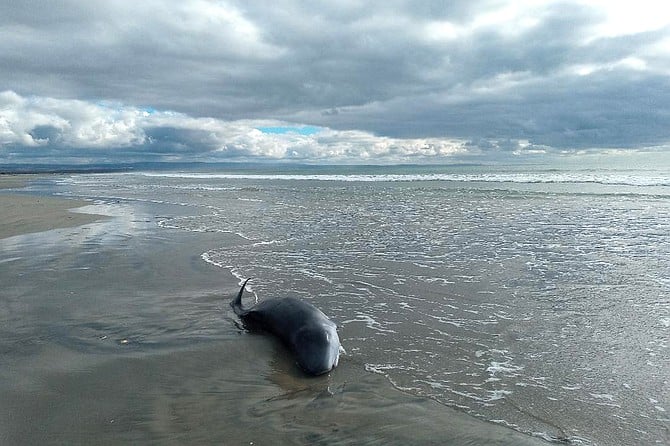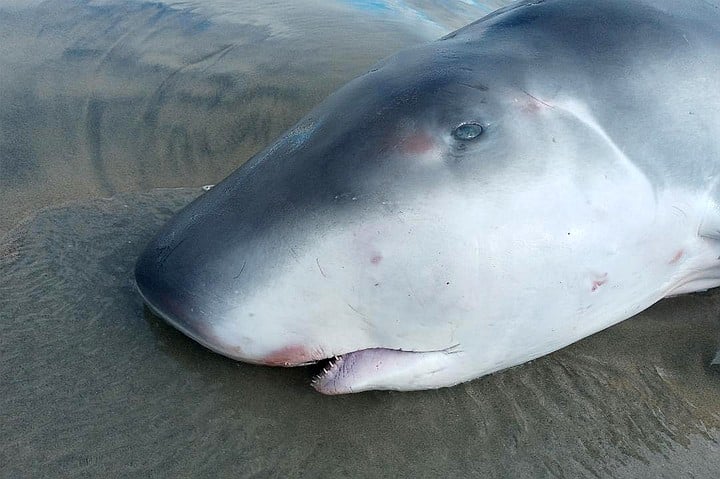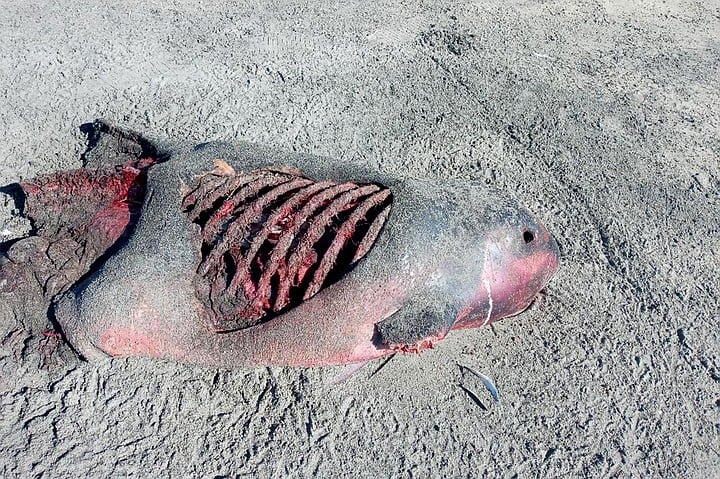 Facebook
Facebook
 X
X
 Instagram
Instagram
 TikTok
TikTok
 Youtube
Youtube

My trusty canine sidekick Flash Gordon and I were heading up the beach twoard the point after a rain squall to check out the fishing on the third day of the new year. I’d heard from a friend there were bonito there, near the Boca of Bahia San Quintin, that were being caught from shore just the day before. Due to the rain and recent high tides flooding ‘Lake Peterman’ between the dunes and Cielito Lindo where we were staying, we couldn’t take the shortcut, so we had to drive our trusty old Jeep around through Pabelón, where there is usually a dry entry through which just about any vehicle can access the beach. From there, on any tide lower than three feet above the mean, one can easily drive along the hard-packed sand in the littoral zone all the way to Punta Azufré at the bay mouth.
When we got to the stretch of beach in front of the Hotel Misión Santa Maria, I saw what I thought was a freshly stranded dolphin and stopped to snap a shot. Usually, stranded dolphins float up dead, and I figured that however it died, the corpse had been pushed up by the storm the night before. But as I focused to take the picture, I noticed the tail fin moving slightly. My first thought was that the receding water had made the fin move. Then I saw the pectoral fin move and realized it must still be alive. I quickly took off my shoes and rolled up my sweats, left Flash in the car so he wouldn’t cause the creature any more stress and ran the fifty yards to the animal.
Upon closer inspection, my first thought was, ‘This is no dolphin.’ It had a bulbous head, a small mouth, and small teeth that I could see only on the bottom jaw. Kind of like a pilot whale, but flatter, and with a smoother head. The tiny dorsal fin was concave and much further back than any dolphin fin I had seen. It was breathing through the single blowhole on its head, and the eyes were clear. The small whale was about 6.5 feet long and looked like it weighed maybe 350 pounds. Getting it back into deep enough water was going to be a task, but I had to try. I think most people would.
I found a little blood on my hands and realized the whale had a couple small cuts toward the tail, maybe from a net. At that point, there was nobody on the beach but a lone local — still a ways off, but pedaling his bike up the beach toward us. Folks often come out on a dropping morning tide after a larger swell for the easy pickings — usually pismo clams and “caracol,” or turban snails, that are churned out and tossed up on the beach by the larger waves.
Speaking of waves: as each one in the next couple sets rolled in, I was able to move the whale out bit by bit, closer to deeper water. But when the swash receded, I could see there was still a bit of work to do, as the water was maybe three inches deep at the low point. Still, the waves were pushing the swash high enough to almost float the whale, and certainly enough to reduce the weight sufficiently to gain some ground with each push of water. After about fifteen minutes, I was about halfway to a point where I figured the whale could try to swim, and I saw the guy on the bike was watching with interest. He walked over and said, “Man, that thing could feed ten or twenty people for a week.”

The whale let out a breath and the man then realized the animal was alive. Without hesitation, this kind man — who had been dry and out for some easy clamming — began helping push the whale out. We quickly managed to get it into deep enough water and aimed out to sea, and the whale actually began swimming through the inner break. But then it turned and swam back to the beach. This happened five or six more times before it finally seemed to get the idea and tried heading straight out through the outer break. By then, maybe a dozen patrons of the Hotel Misión had gathered, and a small cheer arose as my helper and I, both tired and soaking wet, high fived.
Alas, during the last push, the whale exhaled a bit of foam with a slight pinkish hue. I had little hope of it surviving. I still didn’t know what species it was exactly, and wished I’d taken more photos, but the rescue seemed more important at the time. I thanked my helper and headed for the point, feeling good but not optimistic. After a couple of hours fishing — well, me fishing, Flash rolling in the sand and laying in the shade of the Jeep — we headed back with some surf perch in the ice chest. No luck on the bonito, but a couple of the surf perch would make some good ceviche and the rest would go to a friend who loves them fried whole in a disco — basically a wok-type pan with a built in drain rack that can be heated over coals or by a cebolla, which is an onion-shaped burner one attaches to a hose that is fed from a propane tank.
Then I spotted it: there on the beach, maybe fifty yards west of where I first saw it, was the little whale, still and cloudy-eyed. Dead. I got a few pictures for ID purposes and we headed home. I posted the photos on Talk Baja with a request for identification while I searched ‘small toothed whales’ online. Soon I had two possibilities: a dwarf sperm whale or a pygmy sperm whale. The main difference between the two was the location of the dorsal fin. Dwarf sperm whales have a more dolphin-like dorsal about center body, and pygmy sperm whales have a small dorsal more rearward. So this was a pygmy sperm whale: a rarely sighted species about which little is known. (It wasn’t even distinguished as a separate species from dwarf sperm whales until 1966.)
I sent an email to NOAA in case they were interested in noting the stranding or sending anyone to collect samples, then began reading up on the species. Two days after the rescue attempt, I went to check on the corpse. It looked as though someone had sawed off the lower half; maybe the person wanted the fluke for a yard ornament. What was left had been picked to the ribs by vultures and gulls.

The following are notes from NOAA’s page on the species: Pygmy sperm whales are toothed whales named after the waxy substance—spermaceti—found in their heads. The spermaceti is an oil sac that helps the whales focus sound. The whales use echolocation to locate prey. This means that, like bats, pygmy sperm whales use sound to navigate and “see” the world around them. They do so by producing sounds from their melons (or foreheads) that reflect off the objects around them, which the whales perceive as echoes.
Underwater noise pollution can interrupt the normal behavior of pygmy sperm whales, which rely on sound to communicate. As ocean noise increases from human sources, communication space decreases; the whales cannot hear each other, or discern other signals in their environment as they used to in an undisturbed ocean.
Like squid, pygmy sperm whales can produce a dark, ink-like liquid that helps them escape from predators. This “squid tactic” makes them unique among other types of whales — except dwarf sperm whales. Each pygmy sperm whale has a sac filled with dark liquid in its intestine. The whale can release more than 3 gallons of dark, reddish-brown liquid, or “ink,” from this sac. The liquid creates a dark cloud in the water to help protect the whales when they feel threatened or are trying to escape predators.


My trusty canine sidekick Flash Gordon and I were heading up the beach twoard the point after a rain squall to check out the fishing on the third day of the new year. I’d heard from a friend there were bonito there, near the Boca of Bahia San Quintin, that were being caught from shore just the day before. Due to the rain and recent high tides flooding ‘Lake Peterman’ between the dunes and Cielito Lindo where we were staying, we couldn’t take the shortcut, so we had to drive our trusty old Jeep around through Pabelón, where there is usually a dry entry through which just about any vehicle can access the beach. From there, on any tide lower than three feet above the mean, one can easily drive along the hard-packed sand in the littoral zone all the way to Punta Azufré at the bay mouth.
When we got to the stretch of beach in front of the Hotel Misión Santa Maria, I saw what I thought was a freshly stranded dolphin and stopped to snap a shot. Usually, stranded dolphins float up dead, and I figured that however it died, the corpse had been pushed up by the storm the night before. But as I focused to take the picture, I noticed the tail fin moving slightly. My first thought was that the receding water had made the fin move. Then I saw the pectoral fin move and realized it must still be alive. I quickly took off my shoes and rolled up my sweats, left Flash in the car so he wouldn’t cause the creature any more stress and ran the fifty yards to the animal.
Upon closer inspection, my first thought was, ‘This is no dolphin.’ It had a bulbous head, a small mouth, and small teeth that I could see only on the bottom jaw. Kind of like a pilot whale, but flatter, and with a smoother head. The tiny dorsal fin was concave and much further back than any dolphin fin I had seen. It was breathing through the single blowhole on its head, and the eyes were clear. The small whale was about 6.5 feet long and looked like it weighed maybe 350 pounds. Getting it back into deep enough water was going to be a task, but I had to try. I think most people would.
I found a little blood on my hands and realized the whale had a couple small cuts toward the tail, maybe from a net. At that point, there was nobody on the beach but a lone local — still a ways off, but pedaling his bike up the beach toward us. Folks often come out on a dropping morning tide after a larger swell for the easy pickings — usually pismo clams and “caracol,” or turban snails, that are churned out and tossed up on the beach by the larger waves.
Speaking of waves: as each one in the next couple sets rolled in, I was able to move the whale out bit by bit, closer to deeper water. But when the swash receded, I could see there was still a bit of work to do, as the water was maybe three inches deep at the low point. Still, the waves were pushing the swash high enough to almost float the whale, and certainly enough to reduce the weight sufficiently to gain some ground with each push of water. After about fifteen minutes, I was about halfway to a point where I figured the whale could try to swim, and I saw the guy on the bike was watching with interest. He walked over and said, “Man, that thing could feed ten or twenty people for a week.”

The whale let out a breath and the man then realized the animal was alive. Without hesitation, this kind man — who had been dry and out for some easy clamming — began helping push the whale out. We quickly managed to get it into deep enough water and aimed out to sea, and the whale actually began swimming through the inner break. But then it turned and swam back to the beach. This happened five or six more times before it finally seemed to get the idea and tried heading straight out through the outer break. By then, maybe a dozen patrons of the Hotel Misión had gathered, and a small cheer arose as my helper and I, both tired and soaking wet, high fived.
Alas, during the last push, the whale exhaled a bit of foam with a slight pinkish hue. I had little hope of it surviving. I still didn’t know what species it was exactly, and wished I’d taken more photos, but the rescue seemed more important at the time. I thanked my helper and headed for the point, feeling good but not optimistic. After a couple of hours fishing — well, me fishing, Flash rolling in the sand and laying in the shade of the Jeep — we headed back with some surf perch in the ice chest. No luck on the bonito, but a couple of the surf perch would make some good ceviche and the rest would go to a friend who loves them fried whole in a disco — basically a wok-type pan with a built in drain rack that can be heated over coals or by a cebolla, which is an onion-shaped burner one attaches to a hose that is fed from a propane tank.
Then I spotted it: there on the beach, maybe fifty yards west of where I first saw it, was the little whale, still and cloudy-eyed. Dead. I got a few pictures for ID purposes and we headed home. I posted the photos on Talk Baja with a request for identification while I searched ‘small toothed whales’ online. Soon I had two possibilities: a dwarf sperm whale or a pygmy sperm whale. The main difference between the two was the location of the dorsal fin. Dwarf sperm whales have a more dolphin-like dorsal about center body, and pygmy sperm whales have a small dorsal more rearward. So this was a pygmy sperm whale: a rarely sighted species about which little is known. (It wasn’t even distinguished as a separate species from dwarf sperm whales until 1966.)
I sent an email to NOAA in case they were interested in noting the stranding or sending anyone to collect samples, then began reading up on the species. Two days after the rescue attempt, I went to check on the corpse. It looked as though someone had sawed off the lower half; maybe the person wanted the fluke for a yard ornament. What was left had been picked to the ribs by vultures and gulls.

The following are notes from NOAA’s page on the species: Pygmy sperm whales are toothed whales named after the waxy substance—spermaceti—found in their heads. The spermaceti is an oil sac that helps the whales focus sound. The whales use echolocation to locate prey. This means that, like bats, pygmy sperm whales use sound to navigate and “see” the world around them. They do so by producing sounds from their melons (or foreheads) that reflect off the objects around them, which the whales perceive as echoes.
Underwater noise pollution can interrupt the normal behavior of pygmy sperm whales, which rely on sound to communicate. As ocean noise increases from human sources, communication space decreases; the whales cannot hear each other, or discern other signals in their environment as they used to in an undisturbed ocean.
Like squid, pygmy sperm whales can produce a dark, ink-like liquid that helps them escape from predators. This “squid tactic” makes them unique among other types of whales — except dwarf sperm whales. Each pygmy sperm whale has a sac filled with dark liquid in its intestine. The whale can release more than 3 gallons of dark, reddish-brown liquid, or “ink,” from this sac. The liquid creates a dark cloud in the water to help protect the whales when they feel threatened or are trying to escape predators.
Comments